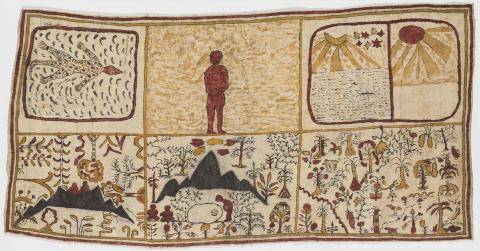Ömie nioge (barkcloth)
'Kin' July 2022
Nioge, or barkcloth, are created by Ömie women from the mountainous Oro Province of Papua New Guinea. These works attest to the extraordinary range of expression available using a restricted colour palette and limited combinations of linear and curvilinear designs over a fibrous surface. Deeply embedded within the creation stories of the Ömie peoples, as well as everyday and ceremonial life, nioge are much more than aesthetic expressions. Like the tattoos once worn by Ömie men, these ‘paper skins’ communicate important information relating to place, resources, customs and people.
In most instances, the designs found on the nioge have been passed from mother to daughter. From a young age, Ömie girls are encouraged to not only copy but also innovate using skills learned through creating in kinship groups. Whereas the fibrous barkcloth that forms the support of the nioge is always created communally, the designs found on each cloth are different, as individual women respond to the textured surface of the cloth and the stories imparted by their elders. In this way, families of artists create a broad repertoire of design combinations to tell their stories. Families can be identified by these marks.
All descend from Suja, the first Ömie woman who, at the culmination of her first menstruation, cut bark from a tree to create a skirt that would tell her husband that her period had ended.

